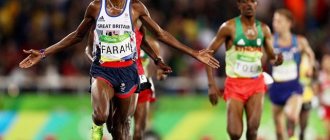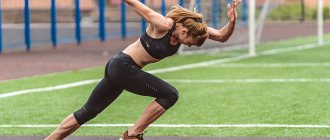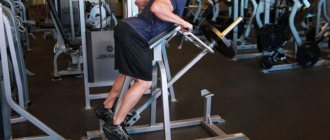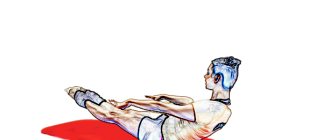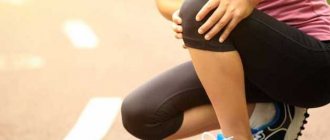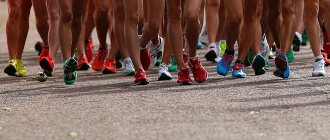Trail running or running on rough terrain—smooth gravel, dirt path, or wood chip trail—impacts muscles, tendons and ligaments are not the same as on a flat track or treadmill. You don’t need to wind up hundreds of kilometers of trails like these marathon runners, like Dean Karnasis or Scott Jurek, to see tangible results from running on natural terrain.
With the help of trail runs with descents and ascents , you can not only strengthen the cardiovascular system, but also build quadriceps , buttock and core muscles, and calf muscles.
You'll also be able to develop a sense of balance and proprioception (the ability to sense your body, movement, and muscle function), which will be beneficial for any sport or physical activity you engage in.
Features of running on a natural landscape
Cross-country running is also called “trail running,” which literally means “running route” in English. Natural terrain is considered more natural for the human body than asphalt or a sports track. However, this does not mean that such a load will be easier for him - running requires maximum concentration and attention from the athlete. The constantly changing route does not allow the body to get used to the load, so the muscles are constantly toned.
This sport requires the athlete to have a developed sense of balance, the ability to feel his body, every muscle and joint. Both endurance and the ability to make decisions on the fly will come in handy.
Pros and cons of trail running
The main advantages of trail running:
- Marked increase in physical fitness (superior to almost all types of running in effect);
- Increased endurance and explosive speed and strength indicators;
- Increased coordination;
- Involves all muscle groups;
- Ability to quickly make decisions, depending on the situation;
- An exciting and fun sport;
- Improves wilderness survival skills.
Despite the impressive list of advantages, this type of running also has a number of disadvantages :
- Requires preliminary physical training (mastering different running techniques, training muscles in the gym, performing other specialized exercises);
- Requires a special form. Regular clothes are not suitable. Everything from a backpack to socks and trail running shoes is selected taking into account the specialization of running;
- Increased injury rate compared to other types of running.
Effect on the body
A great motivation for practicing cross-country running is to consider the benefits it provides to the body.
- Strengthens the cardiovascular and respiratory systems;
- Develops core muscles, quadriceps, gluteal and calf muscles, joints and connective tissues;
- Promotes weight loss (cross country steeplechase has been proven to burn 20% more calories than regular jogging on a track);
- The soft, springy texture is gentle on the joints;
- Improves overall endurance and physical tone;
- Increases self-esteem and self-discipline;
- The psycho-emotional state improves (down with depression, bad mood, fatigue due to stress);
- You will never get bored, because you can change locations every day. By the way, do you know what will happen if you run every day? If not, then it's time to find out!
What are the benefits of cross running?
Cross-country running has a number of differences from other types of running. During exercise, your joints and muscles don't work as hard because your feet are in contact with the ground, a softer surface than asphalt. Professional runners regularly practice trail running to allow their knee joints to recover and rest.
Thanks to cross-country running, the body receives a useful load:
- the strength endurance of the body increases;
- the functioning of the cardiovascular system improves;
- physical tone increases;
- the muscle corset is strengthened;
- the psychological state is normalized - regular cross-country running helps to more easily counteract stress, relieves nervousness and depressed mood;
- self-discipline increases;
- extra pounds are burned, the body becomes slimmer and more toned.
Cross-country running uses a lot of muscles, and with the right approach, gradually increasing the pace and duration of runs, it will serve as a first-class means of keeping your body in great shape. In this case, the likelihood of getting a concussion, sprain or harmful stress on the joints is practically absent.
How to prepare?
So, we have found out the benefits of cross-country running, but don’t rush to immediately run for sneakers. First you need to figure out how to properly prepare for training and where to start.
First of all, choose a suitable location - let it be a flat surface without steep descents, ascents, sand and moving stones. Before starting each workout, do a warm-up - warm up your muscles and stretch your joints.
For the first couple of lessons, we recommend moving at a brisk pace in order to “scout” the situation and adapt to the load. Gradually increase your challenge by increasing the training time from 20 minutes to 1.5 hours, and making the route more difficult.
Choosing shoes for trail running
As motivation, it will be useful to know how trail running affects the human body.
Core muscles
The natural nature of the trails - soft, forgiving surfaces with occasional obstacles in the form of roots or rocks - engages the core muscles to maintain body stability. Therefore, every step taken works to tighten and strengthen the core - the muscles of the middle part of the body.
Core muscles (responsible for stabilizing the pelvis, hips and spine)
Trail running, and downhill running in particular, strengthens and shapes your quadriceps. They act like brakes to keep you from spiraling down too quickly.
Gluteal muscles
Running uphill strengthens your butt muscles. In addition, negotiating narrow paths with obstacles forces the gluteal muscles to actively work to maintain stability.
Calf muscles
Hilly terrain and/or running on particularly difficult routes engages the calf muscles - thanks to them, you can move forward. Every step that requires stability on the trail (this is almost the entire route) begins with the muscles of the foot and lower leg - the calf muscles.
Work of the calf muscles while running
Due to the constant need to maintain stability while running along a route - finding a smoother surface, as well as avoiding obstacles, helps strengthen the connective tissue in the body with each new step taken. This means that the ligaments and tendons surrounding the ankle, knee and hip joint become stronger and less susceptible to various injuries.
Joints
From grass and sand to packed dirt, soft trail surfaces are gentler than asphalt, which puts stress on your joints with every step you take.
Trail running is not only gentle on your joints, but also strengthens them.
The beneficial effects of running in a forest belt on joints
Heart
Trail running strengthens your heart. Consistent variety of natural, aerobic exercise increases cardiovascular endurance, but not in the same way as running on a trail or treadmill. For example, clean mountain air strengthens the heart, treats bronchial asthma, and restores the nervous system.
Research shows that running on natural terrain burns 10% more calories than running on flat trails.
Considering all the benefits described, it is safe to say that trail running will certainly make you stronger, leaner and healthier.
The impact of trail running on general physical condition
Special shoes for running on rough terrain allow you to conduct your workouts comfortably and safely for your joints.
The basic principles that you should rely on when choosing shoes for trail running are:
- Comfort (shoes should match the shape of the foot, take the time to try them on, squat in them, jump, run in place. The upper part of the shoe should not be an obstacle to the free movement of the ankle, and additional ventilation holes will provide ventilation and relieve the ankle from unpleasant sweat odor. At the same time, if you plan to run off-road, where there is a lot of dust and dirt, we recommend choosing shoes with a dense upper material, and not with mesh, which is well suited for running on clean asphalt or a stadium)
- Size (to check whether the shoe size is right for you or not - tie the laces, roll from heel to toe, and if the foot does not fidget or fall off, then it is your size, and you should also pay attention to the space between the toe and the toe shoes, it should be enough so that your toes are not squeezed)
- Insole (the insole in shoes should not wrinkle or wrinkle during active movements of the feet in shoes, so give preference to smooth and thick insoles that are durable and provide easy access to washing and drying after training)
- Lacing and tongue (the standard lacing system in the form of a braid ensures reliable fixation of the foot in the shoe, and the pocket on the tongue will become a convenient element where you can put a tied bow to prevent spontaneous unraveling. Also, Salomon QuickLace polyester lacing has been gaining popularity recently, thanks to its reliability, durability and quick lacing)
- Sole (due to the fact that when running over rough terrain you often come across stones under your feet, uneven, sharp surfaces, you should choose a thick, rough sole that will have enough rigidity, as well as shock-absorbing and tenacious abilities to the surface that will prevent foot injuries, and will give a more comfortable feeling while running. Despite the fact that the sole of the shoe should be rigid, if you choose a “wooden” one, it will be quite difficult for you to run, to avoid this, it should bend at the joint of the toes with metatarsal)
- Shoe toe (soft toe of a shoe, not suitable for running in extreme conditions, therefore many manufacturers of specialized shoes often attach protection to the toe, which protects against stones and other hard objects)
If your financial capabilities do not allow you to purchase professional cross-country running shoes at a sports store, then use our recommendations above. Otherwise, you expose your health and your musculoskeletal system to various injuries, ranging from ordinary sprains to arthritis and arthrosis, injuries to the meniscus and knee ligaments.
For those who do not spare money on high-quality, comfortable and safe shoes for trail running, we suggest paying attention to the following models:
- Salomon S-Lab Fellcross 3
- Asics Sonoma
- Mizuno Wave Kazan 2
- ASICS Gel-Trabuco 10
- Adidas Energy Boost
- The North Face Ultra MT
- Adidas Supernova Sequence Boost 8
- Mizuno Wave Enigma 5
- Nike Free Run Distance
- Puma Speed 300 Ignite
- Haglofs Gram AM II
As with any training program, a gradual approach is very important in trail running. If you are a beginner, choose flat trails to practice your technique and prepare for more difficult routes. Over time, your muscles, joints and ligaments will strengthen gradually and painlessly.
If you find an error, please highlight a piece of text and press Ctrl Enter.
A great motivation for practicing cross-country running is to consider the benefits it provides to the body.
- Strengthens the cardiovascular and respiratory systems;
- Develops core muscles, quadriceps, gluteal and calf muscles, joints and connective tissues;
- Promotes weight loss (cross country steeplechase has been proven to burn 20% more calories than regular jogging on a track);
- The soft, springy texture is gentle on the joints;
- Improves overall endurance and physical tone;
- Increases self-esteem and self-discipline;
- The psycho-emotional state improves (down with depression, bad mood, fatigue due to stress);
- You will never get bored, because you can change locations every day. By the way, do you know what will happen if you run every day? If not, then it's time to find out!
Equipment
Buy quality equipment, paying special attention to the selection of sneakers. If you plan to practice running on rough rocky terrain and overcoming natural obstacles, we recommend choosing shoes with thick grooved soles, durable and elastic, which will absorb well, eliminating discomfort when hitting rocks.
Cross-country running is often accompanied by falls, abrasions and bruises, so take care to protect your elbows, knees and hands. Put a cap on your head and glasses on your eyes. The first will protect from scorching sun rays, the second from sand, midges and excess light.
If you like to train in the cold season, then we recommend you material about running shoes for winter.
Dress according to the season and weather. Clothes should not restrict movement or interfere with jogging. For wet weather, stock up on a waterproof windbreaker, a thick hat in windy weather, and it is better to run in the forest in a long-sleeve T-shirt.
Movement technique
Long running over rough terrain is called cross-country; it requires the athlete to be well prepared and follow the recommended technique. It will come in handy when fatigue appears due to long-term exercise, which, combined with uneven terrain, provokes an increased risk of injury.
The cross-country running technique is, in general, similar to the algorithm for standard races, but there are some peculiarities. For example, to maintain balance and control coordination, you will have to help yourself with your hands, tilt your body, alternate the pace and length of your step, and place your feet in different ways.
Changes in terrain load different muscle groups, so the technique of running up and down differs.
- When climbing uphill, you can slightly lean your body forward, but do not force it. We recommend shortening your step length and vigorously helping yourself with your hands.
- The descent is an equally difficult part of the distance, but not so energy-consuming. Therefore, it is easier to run down, but the risk of injury is much higher. It is better to straighten the body and even tilt it back a little. Do not lift your feet high from the ground, run in small, frequent steps. Bend your arms at the elbows and press them to your body. Place your foot first on the toe, then roll it onto the heel. The exception is loose soil - in these conditions, stick your heel into the soil first, then your toe.
Trail running benefits your mind and body
Running is great, but it can get boring, just like any other monotonous activity that is repeated the same way. If you don't diversify your workouts, you risk losing interest in running.
When the dusty breeze of the concrete jungle doesn't motivate you to go for a run, trail running can be a new incentive to get into running.
By tackling changing terrain, you'll improve your fitness and enjoy the beauty of the natural surroundings, with only your own thoughts to distract you (unless you decide to turn on your favorite podcast). Trail running, while challenging, can be an enjoyable way to recapture your love of running.
Let's look at the benefits of trail running for the mind and body.
Benefits of trail running for the body
From a physical perspective, one of the benefits of trail running is the soft surfaces of most trails, which absorb some of the impact on your joints. By running at a moderate pace, you can also minimize (or even eliminate) the risk of some common injuries caused by the constant impact of your feet on the road surface while you run.
Another plus is the wide variety of trails. Protruding tree roots, rocks, leaves, branches and many other obstacles along the way make running on rough terrain less static than running on a paved road. Adapting to the uneven terrain, you will have to constantly change your running pattern and stride length.
In this sense, trail running can be a great way to develop balance and strengthen muscle groups you haven't used before. Running over rough terrain with overcoming descents, ascents, steps and high altitudes involves a more versatile physical activity.
The Mental Benefits of Trail Running
It is a well-known and studied fact that being in the forest has a calming effect on us. In the fresh air we get rid of stress and tension faster than indoors. Research has proven time and time again that spending time in the woods is good for our brains and cognitive functions. The surrounding picturesque landscapes also lift your spirits.
Additionally, our mental mindset when running trails can be very different from what we think about when we're running on the road. Runners often choose calmer, more relaxed runs as a way to escape the competitive spirit of road running. Most view trail running as a more meditative approach to running and an activity that provides a sense of physical and spiritual harmony with nature.
Cross-country running is an opportunity to forget about calculations and goals, about the stresses of city life, and direct the flow of your thoughts in a different, more pleasant direction. Focus on the run itself while enjoying the peaceful scenery.
Pro tips from runner Michael Wardian
Here are the main benefits of trail running, according to runner Michael Wardian:
- Soft Surface
“Because the ground's soft surface, trail running reduces the risk of overuse injuries as well as the shock that needs to be absorbed—especially as your training volume increases.” - Changing Pace
“The terrain on the trails forces you to run slower and more carefully, which allows you to adapt by getting used to running at a different pace.” - Getting dirt
“It seems to me that dirt, when it gets on the body, causes some unusual sensations, awakening some primitive instincts in you.” - Character Development
“Trail running develops many of the qualities needed to be a runner. Trail running forces you to watch where you step, pace yourself, tackle hills, be careful on downhills, and be responsible for your actions. On the other hand, it is a very accessible sport, and everyone who does this type of running tries to encourage and support you.”
Read more: How to start trail running
How to breathe correctly?
Cross-country or cross-country running requires the athlete to have developed “breathing ability”. Let's look at how to breathe correctly during such races:
- Develop a smooth and even rhythm;
- Breathe naturally, without acceleration or delay;
- It is recommended to inhale through the nose and exhale through the mouth, but when running fast, it is allowed to inhale through both the mouth and nose at the same time.
The technical side of cross running
The technique of cross-country running is somewhat different from regular jogging. When moving on a straight road, you can use the standard technique - a straight torso, arms slightly pressed to the body at a right angle, the foot touches the ground first with the heel, and then rolls onto the toe.
If you have to climb, using such a technique will be quite problematic, since a very large load will be placed on your legs. To make your work easier, you can run with your body slightly bent, but you should not tilt it too much. In addition, you should shorten your stride length and move your arms faster. The movements of the arms will also differ from those when simply running - you need to swing your arms widely, starting the movement from the hip and raising them high to the chest. Climbing puts the most stress on your ankles and feet, so you shouldn't run uphill too often, especially if your goal is to stay in good physical shape rather than prepare for a competition.
When descending, the muscles of the knee and lower leg work the most. If there are problems with the knee joint, this load must be strictly dosed. Overweight people also need to descend extremely carefully so as not to injure their knee. It is recommended to wrap your knees with an elastic bandage - this will give them additional protection and help avoid injury.
An important point is the correct breathing technique. It is advisable to inhale through the nose, exhale through the mouth. If shortness of breath or other discomfort occurs, you can try breathing only through your mouth. Has your heart rate increased? This means that you need to slow down your running pace, or temporarily switch to walking until your heart stops jumping out of your chest.
Competitions
Cross-country running competitions are held regularly around the world. This is one of the Olympic disciplines of athletics, a very popular sport among amateurs today. By the way, it does not have strict requirements for the route. Most often, athletes run in the forest, in a field on grass, in mountainous areas, on the ground. The timing for cross country races usually starts after the end of the main track and field season, and most often occurs during the summer months.
By the way, England is considered the birthplace of trail running; it is there that cross-country running is considered a national sport.
If you are tired of the treadmill in the gym or bored with the city park, feel free to go out of town, right into the field, and start running there. Get acquainted with the steppe fauna - wake up ferrets and lizards. If you live in a mountainous area, even better! Give yourself extreme workouts with frequent changes in altitude - even the most powerful muscleman in the gym will envy your physical shape! Just don’t go too far – start with a small load and assess your strength adequately.
Teach running techniques on soft, loose, viscous soil.
Means: story and visual aids about running technique and its features on soft, loose soil (the surface can be different - sandy, swampy, rocky); slow jogging for 6-7 minutes per km over rough terrain, small accelerations and running uphill 30-80m 5-6 times, running downhill 6-8 times 80-150m.
Methodical instructions: Training sessions are conducted over rough terrain on special soil. The technique of cross-country running changes accordingly; if the ground is loosely viscous, then the leg may sink. It should be taken into account that on loose, soft surfaces, the larger the area of support, the longer the application of the force of the entire surface of the foot on the ground in the repulsion phase, the less the foot sinks into the ground, the more effective the repulsion occurs. In this regard, running technique undergoes the following changes:
- It is necessary to take into account the correct placement of the foot on the ground. Correct push-off is performed with the entire surface of the foot.
- If you run carelessly, without the correct running technique, you can get injured in the Achilles tendon, joints - knees, ankles, etc. Therefore, the principles of gradualness must be taken into account.
The take-off on cross-country trails starts earlier and ends later than in synthetic or road running. Runners with active push-off, with all other qualities being equal, on cross-country tracks, as a rule, lose to runners with passive push-off. You should be extremely careful, without violating the principles of gradualness and accessibility, to include training on the above-mentioned soils, otherwise this leads to injuries, primarily to injuries to the Achilles tendon.

